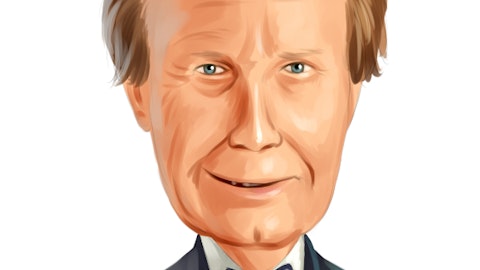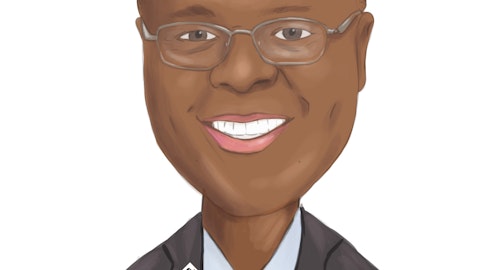Camden National Corporation (NASDAQ:CAC) Q3 2023 Earnings Call Transcript October 31, 2023
Operator: Good day. And welcome to Camden National Corporation’s Third Quarter 2023 Earnings Conference Call. My name is Hannah, and I will be your operator for today’s call. All participants will be in a listen-only mode during today’s presentation. Following the presentation, we will conduct a question-and-answer session. [Operator Instructions] Please note that this presentation contains forward-looking statements, which involve significant risks and uncertainties that may cause actual results to vary materially from those projected in the forward-looking statements. Additional information concerning factors that could cause actual results to differ materially from those in such forward-looking statements are described in the company’s earnings press release and supplemental earnings materials, the company’s 2022 annual report on Form 10-K and other filings with the SEC.
The company does not undertake any obligation to update any forward-looking statements to reflect circumstances or events that occur after the forward-looking statements are made. Any references in today’s presentation to non-GAAP financial measures are intended to provide meaningful insights and are reconciled with GAAP in your press release. Today’s presenters are Greg Dufour, President and Chief Executive Officer; and Mike Archer, Executive Vice President and Chief Financial Officer. Please note that this event is being recorded. At this time, I would like to turn the conference over to Greg Dufour. Please go ahead, sir.
Greg Dufour: Thank you, Hannah. Good afternoon. And welcome to Canada National Corporation’s third quarter 2023 earnings call. Before I begin my comments about our third quarter performance, I’d like to acknowledge the traumatic events that our communities have faced over the past several days since the mass shooting in Lewiston, Maine on October 25th. We have two locations in the direct area and nearly 60 employees who live in the Lewiston-Auburn area, as well as many customers, friends and community members. Although our employees and families are safe, they are impacted by this tragedy and we’ll support them and our communities throughout this ordeal and its aftermath. We reported net income of $9.8 million or $0.67 per diluted share for the third quarter of 2023.
This included the impact of repositioning a portion of our investment portfolio, which generated a $5.3 million pre-tax loss on the sale of securities. Excluding that impact, our adjusted non-GAAP earnings for the quarter would have been $14 million or $0.96 per diluted share on a non-GAAP basis. We expect the changes to our investment portfolio will provide future benefits to our net interest margin, earnings and capital. Overall, we’re projecting a two-and-a-half-year earnback on the transaction, which is within our target range for major financial transactions. Even with the investment loss, income after dividends was accreted to capital for the quarter. Our earnings release also included several reconciliations between GAAP and non-GAAP measurements that exclude the impact of the repositioning of the investment portfolio.
Like many banks, we’re not performing to our historical levels, but we’re showing signs of stabilization and improvement. Strategically, we remain focused on three major efforts, maximizing a net interest margin, building deposits and liquidity and maintaining our asset quality. Our net interest margin for the third quarter was 2.39%, which was 1 basis point less than the previous quarter and with the expect — within the expectations we shared on our last call, and our non-GAAP efficiency ratio for the quarter improved to 60.63%. In addition to seeing our core earnings improve this quarter, our loan-to-deposit ratio of 87% and our tangible common equity ratio of 6.47% as of September 30th demonstrate the many strategies we have undertaken throughout 2023 have fortified our financial strength and resiliency.
I believe our transactions and actions position us well for the future and they will enable us to capitalize on any disruption in our markets as we believe that all of our competitors are as well positioned as we are. I’d be remiss not to recognize this will be the last time I’ll be joining this call as President and Chief Executive Officer of Camden National Corporation. We are anticipating the arrival of my successor, Simon Griffiths, on November 20th and have many — have made many plans for a smooth transition when Simon takes over as President and CEO on January 1st. I’ll be an advisor to Simon and the Board until March 31, 2024, and after getting to know Simon over the past several months and seeing how Camden’s management team has operated through this difficult environment, I know that we, and by that I mean shareholders of which I will remain, are in great hands.
I want to extend my appreciation to our owners, both institutional and individuals, who make up one of the four major groups we serve, which also includes our customers, communities and employees. I also want to thank the stock research analysts who take the time to provide research on our stock, and as well as to keep us on our toes in calls like this. It has been an honor to be part of this great organization for 22 years and humbling to have been CEO for 14 of those. Now I’d like to turn it over to Mike Archer.
Mike Archer: Thank you, Greg, and good afternoon, everyone. This morning we reported a net income for the third quarter of $9.8 million and diluted EPS of $0.67, each lower by 21% on a linked-quarter basis. As we reported in our earnings release, in the third quarter we sold just over 66 million of lower yielding securities to adjust our balance sheet and in doing so we recognized a pre-tax loss of $5.3 million. We will discuss the details of this transaction further in a few minutes. Adjusting for this loss on a tax effective basis, non-GAAP adjusted net income for the third quarter was $14 million and non-GAAP adjusted diluted EPS was $0.96. Each an increase of 13% on a linked-quarter basis. The strength of our core operating earnings and capital allowed us to take a loss of this size comfortably in order to improve our balance sheet position for today’s interest rates.
For the third quarter, our non-GAAP financial return metrics, which excludes the investment loss, improved over the last quarter. Our adjusted return on average assets was 0.97% for the third quarter, compared to 0.87% last quarter and our adjusted return on average tangible equity increased to 14.94% for the third quarter, compared to 13.5% last quarter. We have been consistently communicating that deposits, net interest margin and asset quality are our short-term priorities over the last few quarters and we are seeing the benefits of this play out in our core earnings and key financial metrics. Net interest margin for the third quarter was 2.39%, down 1 basis point from last quarter and within our guidance we gave at our last quarterly earnings call.
We are certainly pleased to see signs of net interest margin stabilizing during the quarter. The various strategies we’ve executed over the last several quarters, including loan and deposit pricing, derivatives and funding have all proven beneficial. Loan balances in third quarter decreased 1% due to a few larger commercial loan payoffs. On the residential mortgage side of the business, we continue to sell all saleable originations and are limiting portfolio volume to manage net growth in the product. On the commercial side, we continue to be selective in our deals and focused on growing and developing full relationships. For the third quarter, our weighted average interest rate for new loan books originations was over 7.6%. Loan pipelines continue to be fairly stable, but we do see signs of activities slowing down across our markets.
Deposit balances in the third quarter were relatively flat, decreasing less than 1%, driven primarily by nearly $98 million of broker CDs maturing and interest checking balances decreasing by 3%. CD balances grew $102.8 million or 23% during the third quarter, mostly offsetting these decreases, excuse me. Our CD strategy has been both to generate new relationships and deepen existing relationships while attracting new deposits. Non-interest income for the third quarter totaled $5.1 million and was half of what we reported for the second quarter. The driver for the decrease was a pre-tax investment loss of $5.3 million that we recorded on the sale of certain investment securities to reposition our balance sheet. We sold $66 million of bonds, yielding 2.31% and reinvested $30 million of proceeds into bonds yielding just over 6%.
The remaining proceeds as of September 30th primarily sat in cash due to timing of the transaction. Subsequent to quarter end, we have used these proceeds to reduce higher cost funding alternatives. As we analyzed the transaction, we took into consideration the yield and life of the securities being sold, our interest rate forecast and the earn back on tangible book value dilution, which we expect to be approximately two and a half years. Non-interest expense for the third quarter was $26.2 million, down 3% on a linked-quarter basis. We continue to manage costs closely in light of current and forecasted market conditions in the near-term. Compensation related costs for the third quarter were down 4% from last quarter as we closely managed staffing levels and adjusted incentive related accruals.
Consulting and professional fees are also lower on a linked-quarter basis by $478,000, primarily due to timing of our annual equity award grant to the company’s directors in the second quarter each year. Our non-GAAP efficiency ratio for the third quarter was 60.63%, compared to 63.0% — 07%, excuse me, the prior quarter. As we work through the CEO transition over the next several months, we anticipate elevated non-recurring costs as a result. Our current estimate for related costs for all of 2023 is approximately $900,000 and another $1.2 million for 2024. Through the nine months ended September 30, we have recognized approximately $600,000 related expenses, including legal and consulting fees, recruiter fees and other equity related costs.
Our total cost estimate for 2023 and 2024 include costs for the overlap of Greg and Simon as we head towards year end and into the first quarter of 2024 to ensure a smooth transition. The company’s financial position continues to be very strong. Credit quality across the loan portfolio remains on solid foot — solid footing, with non-performing loans of 0.16% of total loans and delinquencies were 0.09% of total loans as of September 30th. Up slightly from June 30, but still favorable. The company’s total criticized classified loans improved quarter-over-quarter and stood at 1.06% of total loans as of September 30. We continue to monitor our pre-office loan portfolio closely. Through September 30th, we have not seen any material degradations in this portfolio.
Our pre-office loan exposure as of September 30th was 5% of total loans, consistent with last quarter. Total loan reserves stood at 0.9% of total loans at quarter end, consistent with the second quarter. The combination of lower loan balances, minimal net charge-off and continued favor credit quality metrics led to negative provision expense for the third quarter of $574,000. Uninsured deposits as of September 30 were 24% of total deposits and total uninsured deposits and uncollateralized deposits as of September 30 were 15% of total deposits, each consistent with last quarter. Available liquidity sources as of September 30 were 1.4 times uninsured deposits and 2.1 times uninsured and uncollateralized deposits as of September 30, compared to 1.3 times and 2 times, respectively, as of the end of last quarter.
As of the end of the third quarter of 2023, our capital position remained strong, measured on both a GAAP and regulatory basis. At the end of the third quarter, our tangible common equity ratio was 6.47%, down 11 basis points from last quarter and all of our regulatory capital ratios continue to be well in excess of capital requirements. This concludes our comments. We will now open up the call for questions.
See also David Tepper Latest News and Portfolio Changes and 25 Largest Economies in the World by 2075.
Q&A Session
Follow Camden National Corp (INDEXEURO:CAC)
Follow Camden National Corp (INDEXEURO:CAC)
Operator: Certainly. [Operator Instructions] Our first question comes from the line of Steve Moss with Raymond James. You may proceed.
Steve Moss: Good afternoon, Greg and Mike.
Greg Dufour: Hi, Steve.
Steve Moss: Hi, Greg. I definitely want to wish you best wishes on your retirement here. So hope you enjoy it here.
Greg Dufour: Well, thank you.
Steve Moss: Maybe just starting on the margin here, just kind of curious, you obviously have a lot of moving pieces with the late quarter restructuring and the higher cash position. Just curious as to how you all are thinking about that over the near- to intermediate-term?
Mike Archer: Sure. Great question. So, first off, just because it’s your point, because of timing, we didn’t see that full benefit for the transaction this quarter. So to that end, we see this transaction being 5 basis points to 6 basis points accretive from a margin perspective, Steve. As we think about margin for the fourth quarter, we’re kind of thinking that 235 basis points to 240 basis points plus or minus a few basis points and that is including that benefit.
Steve Moss: Okay. And just in terms of the deposit dynamic, like you guys have used the broker market and obviously, I — it looks like you guys are looking to remix it towards just more traditional CDs. Just kind of how are you thinking about the deposit beta going forward here in a higher for longer environment?
Mike Archer: Yeah. I think it’s on the funding side. I mean, we’ve — I think we communicated last quarter that overall we anticipated our beta to be 35%, 40%. I think we’re inching up that way and I would say probably the same on the retail deposit side, call it, excluding the broker, somewhere in that neighborhood as well is what we’re thinking for full cycle. I think to your point, to the extent that we’re in this rate environment for longer than maybe even we anticipate or expect, certainly we could continue to see some upward pressure on that. But based on where we’re at right now, that’s what we’re thinking.
Steve Moss: Okay. And in terms of just the on the loan pipeline here, just curious, how is activity these days? I hear you guys controlling the resi side. We’re just curious about the pipeline and where is loan pricing as well?
Greg Dufour: Yeah. Sure. Steve, I’ll — this is Greg. I’ll take that. And we are still increasing rates, shooting up now, honestly, close to an 8% handle, not there completely across all products, but getting there. So that has slowed down the pipeline. And as Mike mentioned, one of the reasons why we saw a small reversal of some of our reserves because of that. So we’re really prioritizing net interest margin over loan growth and letting that settle in and seeing what opportunities will present itself in the future, kind of keeping our product dry, if you will.
Steve Moss: Okay. Great. And then, maybe just one more here just on the competitive environment like, historically, we’ve talked about loans and deposits very competitive. Have things eased up overall or kind of just curious what your sense for the overall market?
Greg Dufour: No. It’s still extremely competitive on both sides, but especially deposits. As you and a lot of folks know, in Maine, we have a lot of credit unions, a lot of mutuals. They tend to see their loan to deposit ratios run higher. So they’re pricing up deposits to reflect that and so what we have done is that we do it, we just mentioned it earlier to a group that it’s almost like hand-to-hand combat on deposit pricing, but we’re prioritizing relationships versus transactions.





